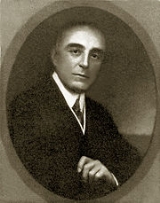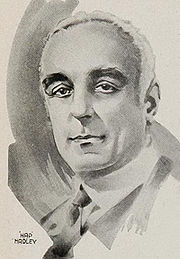
Jules Brulatour
Encyclopedia

United States
The United States of America is a federal constitutional republic comprising fifty states and a federal district...
silent cinema. Beginning as American distribution representative for Lumiere Brothers raw film stock in 1907, he joined producer Carl Laemmle
Carl Laemmle
Carl Laemmle , born in Laupheim, Württemberg, Germany, was a pioneer in American film making and a founder of one of the original major Hollywood movie studios - Universal...
in forming the Motion Picture Distributing and Sales Company
Motion Picture Distributing and Sales Company
The Motion Picture Distributing and Sales Company was a motion picture distribution company that operated in the United States between 1910 and 1912...
in 1909, effectively weakening the stronghold of the Motion Picture Patents Company
Motion Picture Patents Company
The Motion Picture Patents Company , founded in December 1908, was a trust of all the major American film companies , the leading film distributor and the biggest supplier of raw film stock, Eastman Kodak...
, headed by Thomas Edison
Thomas Edison
Thomas Alva Edison was an American inventor and businessman. He developed many devices that greatly influenced life around the world, including the phonograph, the motion picture camera, and a long-lasting, practical electric light bulb. In addition, he created the world’s first industrial...
, a large trust company that was then monopolizing the American film industry through contracts with hand-picked, established studios.
Through the new Sales Company, the growing number of independent filmmakers were able to obtain raw stock from Lumiere, for which Jules Brulatour remained sole US distributor, thereby avoiding strictures imposed by its rival and cutting into profits for Kodak mogul George Eastman
George Eastman
George Eastman was an American innovator and entrepreneur who founded the Eastman Kodak Company and invented roll film, helping to bring photography to the mainstream...
, whose film supply was exclusive to the Patents Company. Eastman soon realized he was on the losing side and approached Brulatour with a contract to sell his stock to the independents through the Sales Company. Brulatour accepted and his long association as head of distribution for Eastman Kodak
Eastman Kodak
Eastman Kodak Company is a multinational imaging and photographic equipment, materials and services company headquarted in Rochester, New York, United States. It was founded by George Eastman in 1892....
began.
In addition to his position with Kodak and his presidency of the Sales Company, Jules Brulatour launched the Animated Weekly newsreel series and co-founded Peerless Pictures. He was also an advisor and producer for the French-based Eclair Film Company, which opened in 1911 an extensive, state-of-the-art studio at Fort Lee, New Jersey
Fort Lee, New Jersey
Fort Lee is a borough in Bergen County, New Jersey, United States. As of the 2010 United States Census, the borough population was 35,345. Located atop the Hudson Palisades, the borough is the western terminus of the George Washington Bridge...
, then the center of the burgeoning American movie industry. Eclair was a leader in technical and artistic advancements afoot in filmmaking at the time, and its American branch was hailed as a mecca for top talent, which Brulatour helped cultivate. In fact, its first leading lady, Dorothy Gibson
Dorothy Gibson
Dorothy Gibson was a pioneering American silent film actress, artist's model and singer active in the early 20th century. She is best remembered as a survivor of the sinking of the RMS Titanic.-Early life and career:...
, already well-known as a model for leading illustrator Harrison Fisher
Harrison Fisher
Harrison Fisher was an American illustrator.Fisher was born in Brooklyn, New York City and began to draw at an early age. Both his father and his grandfather were artists. Fisher spent much of his youth in San Francisco, and studied at the San Francisco Art Association...
, not only became a big star in Eclair vehicles but she landed the married Brulatour as a boyfriend.

Saved From the Titanic
Saved From the Titanic is a 1912 silent motion picture short starring Dorothy Gibson, an actual survivor of the sinking of the RMS Titanic.The movie was shot in less than two weeks and in black and white, with color scenes...
(1912), based on her real-life experiences as a survivor of the famous maritime disaster. The movie, produced by Brulatour, was the first of many cinematic and theatrical productions about the sinking. It was released 16 May 1912, just over a month after the Titanic went down. Brulatour also produced the first newsreel about the Titanic disaster (Animated Weekly, issue No. 7, released 22 April 1912).
After the success of Saved From the Titanic, Dorothy Gibson retired from Eclair, choosing to study opera which Brulatour encouraged and financed. In 1913 her new career was interrupted when she was involved in a car accident in which a pedestrian was killed. The resulting law suit revealed that the car driven by Dorothy was owned by Jules Brulatour and that she was his lover. Although he was already separated from his wife, Clara Isabelle Brulatour, the court scandal prompted her to initiate a divorce which was finalized in 1915. With Clara he had three children, Claude Jules, Yvonne, and Ruth Marie.
Meantime, Brulatour had teamed up again with Carl Laemmle to form the Universal Film Manufacturing Company
Universal Film Manufacturing Company
The Universal Film Manufacturing Company was a corporate precursor to Universal Pictures, and what is now known as Universal Studios.Universal Film Manufacturing Company was incorporated April 30, 1912 in New York...
, later known as Universal Pictures
Universal Pictures
-1920:* White Youth* The Flaming Disc* Am I Dreaming?* The Dragon's Net* The Adorable Savage* Putting It Over* The Line Runners-1921:* The Fire Eater* A Battle of Wits* Dream Girl* The Millionaire...
. This corporation, begun in 1912, drew together competing studios in an unprecedented amalgamation of talent and resources. Serving as Universal's first president, Brulatour was accused of conflict of interest by George Eastman, and although he denied the charge, he resigned. Despite its unfortunate outcome for Brulatour personally, the consolidation of the leading independent filmmakers under the umbrella of Universal was a major turning point in the history of American motion pictures. The merger not only signaled the triumph of a free market in the industry but lead to the creation of the first major Hollywood studio –– Universal City
Universal City, California
Universal City is a community in the San Fernando Valley region of Los Angeles County, California, that encompasses the 415 acre property of Universal Studios...
, constructed in 1914–1915 in Los Angeles
Los Ángeles
Los Ángeles is the capital of the province of Biobío, in the commune of the same name, in Region VIII , in the center-south of Chile. It is located between the Laja and Biobío rivers. The population is 123,445 inhabitants...
in an effort by Laemmle to centralize operations.
In 1914 Brulatour funded the construction of larger studios for Peerless Pictures at Fort Lee as well as the rebuilding of Eclair's processing laboratory, storage vault and offices, which had burned, destroying negatives for almost all the firm's films made over the last three years.
Throughout 1915-1916, while his girlfriend appeared with moderate success in Metropolitan Opera House productions, Brulatour was promoted to the presidency of the Eastman Kodak Company. He also helped form another studio at Fort Lee, Paragon Films, for which he built a large facility specifically for the on-site production of Eastman stock.
By 1917 Jules Brulatour was a very rich man, reportedly worth several million dollars, and he was increasingly powerful politically. That year he was appointed to the executive committee of the National Association of the Motion Picture Industry. Brulatour chiefly conferred with the group's War Cooperation Subcommittee, which networked with the US government for the promotion of public welfare and propaganda films.
It is believed that his sudden high profile in Washington, D.C.
Washington, D.C.
Washington, D.C., formally the District of Columbia and commonly referred to as Washington, "the District", or simply D.C., is the capital of the United States. On July 16, 1790, the United States Congress approved the creation of a permanent national capital as permitted by the U.S. Constitution....
determined him to legitimize his relationship with Dorothy Gibson, whom he finally married on July 6, 1917, a week before his first conference with President Woodrow Wilson
Woodrow Wilson
Thomas Woodrow Wilson was the 28th President of the United States, from 1913 to 1921. A leader of the Progressive Movement, he served as President of Princeton University from 1902 to 1910, and then as the Governor of New Jersey from 1911 to 1913...
and United States Treasury Department Secretary McAdoo.
The next year Jules Brulatour was invited to join the film division of President Wilson's Committee of Public Information, but this appointment was less fruitful. Arguments and financial troubles arose almost immediately, and allegations flew of undue influence from media baron William Randolph Hearst
William Randolph Hearst
William Randolph Hearst was an American business magnate and leading newspaper publisher. Hearst entered the publishing business in 1887, after taking control of The San Francisco Examiner from his father...
and even of bribes from Brulatour; nothing was proven but he resigned under pressure.
Privately, Brulatour's life was also unraveling. His marriage to Dorothy infuriated his first wife, who started proceedings against him, claiming the union was illegal since he had obtained a divorce in Kentucky
Kentucky
The Commonwealth of Kentucky is a state located in the East Central United States of America. As classified by the United States Census Bureau, Kentucky is a Southern state, more specifically in the East South Central region. Kentucky is one of four U.S. states constituted as a commonwealth...
instead of New York, the state of his residency. This was a drawn-out, complicated affair, and the stress ruined his second marriage, which was finally dissolved as an invalid contract in 1919, a humiliated Dorothy Gibson leaving New York shortly thereafter to live in relative peace and anonymity in Paris.
In 1923 Jules Brulatour married a third time. His new wife was starlet Hope Hampton
Hope Hampton
Hope Hampton was an American silent motion picture actress, who was noted for her seemingly effortless incarnation of siren and flapper types in silent-picture roles during the 1920s....
, a Texas-born beauty queen who was just beginning in movies. Though still head of Kodak, Brulatour was increasingly interested in his new bride's career, which he personally managed. Like Dorothy before her, Hope's film work was short-lived, and she took another page from her predecessor's book when she decided to go into opera, urged on and funded by Brulatour.
In 1924 after Kodak was investigated by the Federal Trade Commission
Federal Trade Commission
The Federal Trade Commission is an independent agency of the United States government, established in 1914 by the Federal Trade Commission Act...
Brulatour was severely fined, along with George Eastman, for "conspiracy to hinder and restrain commercial competition."

Park Avenue (Manhattan)
Park Avenue is a wide boulevard that carries north and southbound traffic in New York City borough of Manhattan. Through most of its length, it runs parallel to Madison Avenue to the west and Lexington Avenue to the east....
" in the society columns.
But there were a few odd episodes, such as an unsolved shooting incident in 1939, in which Brulatour was wounded by a would-be assassin whom he refused to identify. And in 1941, he and Hope were surprised to learn that Citizen Kane
Citizen Kane
Citizen Kane is a 1941 American drama film, directed by and starring Orson Welles. Many critics consider it the greatest American film of all time, especially for its innovative cinematography, music and narrative structure. Citizen Kane was Welles' first feature film...
, the hit RKO film directed by and starring Orson Welles
Orson Welles
George Orson Welles , best known as Orson Welles, was an American film director, actor, theatre director, screenwriter, and producer, who worked extensively in film, theatre, television and radio...
, was partly based on Brulatour and his wives.

